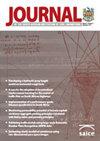是什么导致了中国西部山区高速公路上严重的多车撞车事故?
IF 0.6
4区 工程技术
Q4 ENGINEERING, CIVIL
Journal of the South African Institution of Civil Engineering
Pub Date : 2022-03-25
DOI:10.17159/2309-8775/2022/v64no1a6
引用次数: 1
摘要
本文调查了中国西部山区高速公路上多车相撞事故的发生情况和严重程度。通过部分约束广义有序logit分析了2012年至2017年间发生在中国陕西一条典型山区高速公路上的1521个车祸样本,以确定导致此类车祸严重程度的重要风险因素。进行弹性分析以量化每个独立解释变量对碰撞严重程度结果的影响。共发现14个解释变量对MME撞车的可能性有显著影响。这些因素包括碰撞类型、故障驾驶员的年龄、疲劳驾驶、驾驶时使用手机、酒精受损驾驶、超速行驶、危险跟车和危险超车行为、道路急转弯和路面湿滑、季节、一周中的哪一天、一天中的什么时候以及恶劣天气(雨/雪/雾)。还探讨了这些变量对碰撞严重程度的影响。总之,研究结果可为制定立法和技术对策以确保中国西部山区高速公路的交通安全提供有益的指导。本文章由计算机程序翻译,如有差异,请以英文原文为准。
What leads to severe multi-vehicle crashes on mountainous expressways in Western China?
This paper investigates the occurrence and severity of collisions involving multiple vehicles on mountain expressways (MMEs) in Western China. A total of 1 521 crash samples occurring on one typical mountain expressway in Shaanxi, China, between 2012 and 2017, were analysed through a partially constrained generalised ordered logit to identify the significant risk factors contributing to the severity of such crashes. Elasticity analysis was performed to quantify the effects of each independent explanatory variable on the collision severity outcomes. Fourteen total explanatory variables were found to have a significant and pronounced influence on the likelihood of MME crashes. These include the type of collision, the at-fault driver's age, driving while fatigued, cell phone use while driving, alcohol-impaired driving, speeding, risky following and dangerous overtaking behaviour, sharp curves in the roadway and slippery pavement conditions, seasons, day of the week, time of day, and adverse weather (rain/snow/fog). The impacts of the variables on the collision severity were also explored. Taken together, the findings may serve as a useful guide for developing legislation and technical countermeasures to ensure traffic safety on mountain expressways in Western China.
求助全文
通过发布文献求助,成功后即可免费获取论文全文。
去求助
来源期刊
CiteScore
0.70
自引率
25.00%
发文量
19
审稿时长
>12 weeks
期刊介绍:
The Journal of the South African Institution of Civil Engineering publishes peer reviewed papers on all aspects of Civil Engineering relevant to Africa. It is an open access, ISI accredited journal, providing authoritative information not only on current developments, but also – through its back issues – giving access to data on established practices and the construction of existing infrastructure. It is published quarterly and is controlled by a Journal Editorial Panel.
The forerunner of the South African Institution of Civil Engineering was established in 1903 as a learned society aiming to develop technology and to share knowledge for the development of the day. The minutes of the proceedings of the then Cape Society of Civil Engineers mainly contained technical papers presented at the Society''s meetings. Since then, and throughout its long history, during which time it has undergone several name changes, the organisation has continued to publish technical papers in its monthly publication (magazine), until 1993 when it created a separate journal for the publication of technical papers.

 求助内容:
求助内容: 应助结果提醒方式:
应助结果提醒方式:


